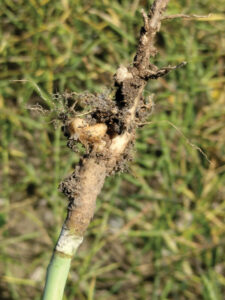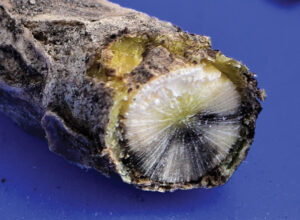Genetics: six studies
Lower auxin response decreased clubroot severity
Key result:
The clubroot pathogen uses the plant’s hormone auxin to help make galls. Canola plants with less auxin response have lower clubroot severity.
Project name, principal investigator:
“Increasing abiotic (drought) and biotic (clubroot) resistance in Brassica species (Arabidopsis and Canola) by modifying auxin response” Jocelyn Ozga, Stephen Strelkov, Guanqun Chen, Sheau-Fang Hwang, University of Alberta
Funding:
SaskOilseeds, Alberta Canola, Natural Sciences and Engineering Research Council of Canada
Auxin is a natural plant-growth hormone in all plants. The clubroot pathogen may actually use that auxin to develop galls. If brassica plants have lower auxin response, would clubroot disease severity drop?
To test that question, researchers started with the canola relative arabidopsis. They used transgenics to insert a pea auxin receptor gene into arabidopsis, and it reduced the arabidopsis auxin response and decreased clubroot severity. They then inserted this pea gene into canola. Canola transgenic lines expressing the pea auxin receptor also showed reduced clubroot disease symptoms. Reducing auxin response is a potential mechanism to partially suppress clubroot progression in future canola cultivars.

Progress on drought-tolerant canola
Key result:
When researchers use gene-editing and RNAi to suppress the Kanghan gene family in canola, the crop seems to have higher drought tolerance.
Project name, principal investigator:
“Drought tolerance in canola through modulating the Kanghan (KH) gene family” Jitao Zou, Wenyun Shen, Hui Yang, National Research Council
Funding:
SaskOilseeds, Manitoba Canola Growers, Western Grains Research Federation
Researchers tested transgenic introduction of single genes for drought tolerance with limited success. However, canola lines with the Kanghan (KH) family of genes suppressed, or turned off, could produce higher yields under drought conditions.
Growth chamber assessment demonstrated that RNA interference (RNAi) of the KH gene family in canola leads to drastically improved drought tolerance. Researchers then moved to confined field trials in the Okanagan Valley of British Columbia to assess water-limited yield potential under field conditions. This project also conducted CRISPR gene editing of the KH genes in canola to generate stable knockout lines with improved drought tolerance.
The Okanagan trial seasons were excessively dry and hot, and there was noticeable unevenness of soil quality at different sections of the trial site. Even so, some of RNAi lines performed better than the control. Also, during the 2023 growing season, the RNAi lines with better yield displayed consistent yield advantage across a majority of trial subsections.
Clearing a path for capturing diversity
Key result:
Researchers identified a gene in canola responsible for protecting genetic purity. Controlling this gene could make it easier to “diversify”
the canola genome, and introduce more yield-resilient canola cultivars.
Project name, principal investigator:
“Manipulating recombination in crop polyploids” Isobel Parkin, AAFC Saskatoon
Funding:
SaskOilseeds, SaskWheat, Agriculture and Agri-Food Canada, National Research Council
Canola and wheat are complex polyploid species – species with multiple sets of chromosomes – with mechanisms within their DNA to strongly protect genetic purity. These mechanisms can make it difficult to introduce new diversity, especially from wild relatives, which often carry useful resistance to common stresses. By manipulating these mechanisms it is possible to encourage exchange of genetic material within and between species and to potentially speed up the process of plant breeding. This project aimed to identify key genes involved in this mechanism, and use that knowledge to pave a pathway to more readily manipulate the genome of complex crops.
Genetic analyses of canola identified three quantitative trait loci (QTL) – bits of genetic material – involved in this mechanism. One, called the Brassica Ph1 gene, is particularly strong. Controlling that gene has applications for both increasing stability in canola, which ensures yield performance, and disrupting recombination in order to introduce new genetic variation. This could allow breeders to improve complex traits that lead to more yield-resilient canola cultivars.
Second-generation clubroot resistance wildly inconsistent
Key result:
Growers cannot assume second generation clubroot resistance is “enhanced” resistance.
Project name, principal investigator:
“New clubroot pathotypes and second generation resistance” Stephen Strelkov, Sheau-Fang Hwang, Rudolph Fredua-Agyeman, Keisha Hollman, Emilee Storfie, Victor Manolii, University of Alberta
Funding:
SaskOilseeds, Alberta Canola, Western Grains Research Foundation
The first generation of canola resistance introduced to Canadian canola cultivars all came from the same source, a European cultivar called Mendel. Second generation resistance comes from various sources, and results from this study show a great deal of inconsistency in their reactions to clubroot.
Prairie soils have a growing number of clubroot pathotypes, which can change in response to the host grown in the field. This presents a challenge for genetic resistance, a critical tool for clubroot management. Second-generation resistance offers promise against pathotypes that can overcome first-generation resistance.
Researchers conducted annual surveys to assess the occurrence of clubroot on canola with second-generation resistance. They extracted resting spores from symptomatic canola roots, with the spores obtained from one plant regarded as one field isolate. And they evaluated isolates for pathotype classification on the Canadian Clubroot Differential set and for virulence on seven canola cultivars with second-generation resistance and three control host varieties.
Some second-generation cultivars evaluated in this study exhibited significantly improved resistance to pathogen isolates that were virulent on first-generation resistance. Other second-generation cultivars had resistance profiles that were either similar or notably inferior to first-generation resistance.
Key advances in blackleg breeding
Key result:
An indoor quantitative trait loci (QTL) test will reduce the time required to identify and incorporate adult plant resistance genes into commercial canola varieties.
Project name, principal investigator:
“Towards better understanding of genetics in Leptosphaeria-Brassica interactions via international collaborations to standardize the nomenclature of blackleg resistance genes” Hossein Borhan, Gary Peng, Agriculture and Agri-Food Canada Saskatoon; Dilantha Fernando, University of Manitoba
Funding:
SaskOilseeds, Alberta Canola, Manitoba Canola Growers
This project validated an indoor quantitative trait loci (QTL) test that will reduce the time required to identify and incorporate adult plant resistance genes into commercial canola varieties. A round of indoor screening using this new method takes 10 to 12 weeks. Field-based screening provides one round per growing season. The indoor test also eliminates environmental variations that impact the field results.
This project also developed five new Brassica napus (canola) lines with single resistance (R) genes. Researchers provided these lines to canola breeders to generate canola varieties with highly effective R genes against blackleg. They also developed and validated additional markers to determine blackleg pathogen races and the R gene profile of canola cultivars.
Through a collaboration among Canadian research labs and researchers in Australia and France, these investigators developed a common set of blackleg pathogen races, Brassica napus lines with single R genes, tools such as markers for genotyping pathogen and plant, and protocols for adult plant resistant gene screening. They also developed tools to identify the specific virulence gene AvrLms-Lep2.
Faster blackleg and clubroot tests
Key result:
Researchers developed a faster and more accurate way to scan plant and soil samples for blackleg pathogen races and clubroot pathotypes.
Project name, principal investigator:
“From field to the genome – application of third generation sequencing to direct genotyping of canola pathogens” Hossein Borhan, Tim Dumonceaux, Agriculture and Agri-Food Canada Saskatoon; Stephen Strelkov, University of Alberta
Funding:
SaskOilseeds, Alberta Canola
This project developed a high-throughput and accurate pathogen genotyping method to determine the blackleg pathogen races present in canola stems and clubroot pathotypes present in root galls and soil samples. The method is much faster and precise than the PCR-based system, and can also identify several other fungal pathogens on the same samples.
Knowledge of pathogen races is essential for the successful prevention of crop pathogens. Plant pathogen virulence genes, also known as effectors, can mutate rapidly and generate new pathogen races/pathotypes that overcome disease-resistant varieties. Detecting and tracking changes in the effector genes of pathogens is important for crop disease management.
Unlike PCR markers, targeted sequencing not only identifies known mutations in the genes of interest but also detects new mutations. Commercial labs would need sequencing capability and training to use these tests.





